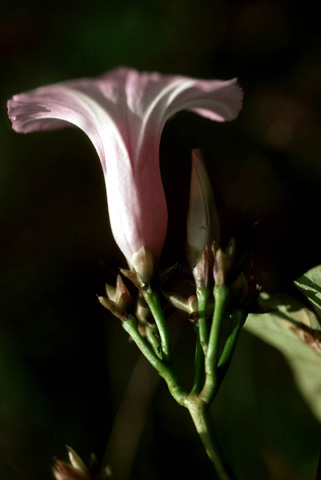
One Potato, Two Potato...Ipomoea batatas!
Batata...What???
 -The sweet potato, or more scientifically, Ipomoea batatas, is a
herbaceous perennial vine that has
white and purple flowers, large nutritious storage roots and
heart-shaped lobed leaves.
-The sweet potato, or more scientifically, Ipomoea batatas, is a
herbaceous perennial vine that has
white and purple flowers, large nutritious storage roots and
heart-shaped lobed leaves.
When most people see sweet potatoes sitting on the shelf at the local grocery store, they don’t see the impact that this organism has had on today’s world. Whether it is lack of awareness or appreciation, sweet potatoes don't seem to receive the credit that they deserve for their excellence. But where exactly did this organism originate? Why is it so popular among developing countries? The past decade has proven to be the first global effort to understand this plants full potential as a food, but how else can this organism be used? Want the answers to these questions? Keep reading!!
History
 Along side the question of what this plant can do for the world,
scientists still seem to be asking where this super plant came from.
It is popular belief that
Ipomoea batatas, or common name “Sweet Potato,” was domesticated
over 5000 years ago. According to published work from the
International Potato Center, it is still unclear whether this took
place in South America or Central America. The International Potato
Center consists of a team of scientists from 25 countries who seek
to achieve food security in developing countries through scientific
research on white potatoes, sweet potatoes, and other tuber and root crops.
In contrast, more recently published
work from the Library of Congress states that the earliest
cultivation records of the sweet potato date to 750 BCE in Peru.
Both sources suggest that the plant was first introduced into China
in early 1600’s by Portuguese explorers. Because it’s planting
material can be multiplied greatly from very few roots and its
distinguished adaptability, the sweet potato spread quickly
throughout Asia, Latin America, and Africa during the 17th
and 18th centuries. The
sweet potato strains date from the first voyage of Columbus in 1492,
which resulted in the introduction of West Indian sweet potatoes in
Europe. The wild ancestor of the sweet potato still has not been
identified.
Along side the question of what this plant can do for the world,
scientists still seem to be asking where this super plant came from.
It is popular belief that
Ipomoea batatas, or common name “Sweet Potato,” was domesticated
over 5000 years ago. According to published work from the
International Potato Center, it is still unclear whether this took
place in South America or Central America. The International Potato
Center consists of a team of scientists from 25 countries who seek
to achieve food security in developing countries through scientific
research on white potatoes, sweet potatoes, and other tuber and root crops.
In contrast, more recently published
work from the Library of Congress states that the earliest
cultivation records of the sweet potato date to 750 BCE in Peru.
Both sources suggest that the plant was first introduced into China
in early 1600’s by Portuguese explorers. Because it’s planting
material can be multiplied greatly from very few roots and its
distinguished adaptability, the sweet potato spread quickly
throughout Asia, Latin America, and Africa during the 17th
and 18th centuries. The
sweet potato strains date from the first voyage of Columbus in 1492,
which resulted in the introduction of West Indian sweet potatoes in
Europe. The wild ancestor of the sweet potato still has not been
identified.
Sweet Potato Crops
 Because this plant has been
domesticated for so long, it has evolved features that have turned
it into a perfect crop plant. Agriculturally, the sweet potato is
the fifth most grown food crop in developing countries after rice,
wheat, maize, and cassava. This ranking is
supported by the fact that sweet potatoes are responsible for over
133 million tons of production every year. Of the total 133 million tons, China is responsible for
117 million tons of annual production. The sweet potato has several
historical uses in China including food security crops, staple crops
in lower income mountainous areas, and as livestock feed. Livestock
feed accounts for about half of total production. In contrast,
Africa only produces seven million tons of sweet potatoes each year
and almost all is used for human consumption. In eastern Africa,
sweet potato is called cilera
abana, meaning, “protector of the children.” This name reflects
the crucial roll that the sweet potato has in thousands of villages
throughout Africa.
Because this plant has been
domesticated for so long, it has evolved features that have turned
it into a perfect crop plant. Agriculturally, the sweet potato is
the fifth most grown food crop in developing countries after rice,
wheat, maize, and cassava. This ranking is
supported by the fact that sweet potatoes are responsible for over
133 million tons of production every year. Of the total 133 million tons, China is responsible for
117 million tons of annual production. The sweet potato has several
historical uses in China including food security crops, staple crops
in lower income mountainous areas, and as livestock feed. Livestock
feed accounts for about half of total production. In contrast,
Africa only produces seven million tons of sweet potatoes each year
and almost all is used for human consumption. In eastern Africa,
sweet potato is called cilera
abana, meaning, “protector of the children.” This name reflects
the crucial roll that the sweet potato has in thousands of villages
throughout Africa.